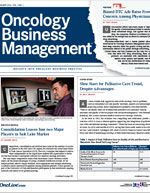Panelists Predict FFS Will Grow More Cumbersome
Tremendous consolidation of remaining independent oncology practices is very likely under scenarios.
Scott Gottlieb, MD
Tremendous consolidation of remaining independent oncology practices is very likely under scenarios painted by panelists at the 4th Annual Patient-Centered Oncology Care conference, sponsored by the American Journal of Managed Care.
The closing panel discussion of the two-day event, held in November, brought together an independent practice representative and a former director of medical policy development for the FDA.
The Centers for Medicare & Medicaid Services (CMS) has a strong desire to make accountable care organizations (ACOs) work, but there are many variables, and panelists said further experimentation with this form of care could have the effect of driving physicians out of fee-for-service (FFS) and into Medicare Advantage, where group health programs administer Medicare payment.
However, the degree to which oncology practices will participate in this migration is unclear, because many of them are falling into the gravitational pull of expanding hospital systems, the panelists said. Yale-New Haven Hospital is an example of a growing, all-encompassing conglomerate, said participant Ted Okon, executive director of the Community Oncology Alliance (COA): “What’s called Jaws in Connecticut is also known as Yale. They’ve bought up everything in the entire state.”
CMS has attempted to tailor ACOs to a variety of health organizations so that each is comfortable with the level of risk it is undertaking though participation. The Medicare Access & CHIP Reauthorization Act, for example, offers the choice of participation in an Alternative Payment Model or just FFS. Similarly, the Oncology Care Model, scheduled for launch in spring of 2016, allows for innovative forms of reimbursement.
These programs have yet to show their worth, and there is evidence that ACOs have stumbled in various respects, other panelists responded. Okon said that ACOs reminded him of homeowners associations that require numerous permissions even for relatively minor things, such as paint colors and landscaping. Despite that level of control, a single large expense for an uncovered drug can take a practice completely by surprise and “bust the bank,” Okon said.
On the other hand, Okon said, raising the example of the Oncology Medical Home form of integrated care that COA has promoted, better coordination and patient-centered care can enable a family to avoid a trip to the emergency department because off-hours oncology care is available through a practice location. In one such instance, payment was vastly simplified, Okon said. “It wasn’t ‘Ka-ching! Ka-ching! Ka-ching!’”
Another problem with the increasing emphasis on ACOs has to do with the government’s lack of experience with managing multiple complex payment models and measuring outcomes, said panelist Scott Gottlieb, MD, a resident fellow at the American Enterprise Institute and a former medical policy development director at the FDA. “They’re not necessarily having the outcomes that CMS had hoped for,” he said, adding that the future for ACOs doesn’t look promising. “I think they’ll be hard-pressed to make these partially capitated models and the ACO construct work.” “You’re seeing more rhetoric in Washington from individuals who were previously champions of ACOs who recognize some of the growing pains. Now they’re saying, ‘Well, they weren’t the ultimate model we had in mind. They were there to test the transfer of risk,’ so you’re seeing some moving away. In a field that’s is as fast-moving as oncology, reimbursement models that are based on backward measures of risk and cost are going to make it more challenging in this setting than others.”
As these programs falter, CMS is likely to fall back on elements of cost management with which it has been successful, such as bundled care, Gottlieb said.
The panel discussion touched on measures of performance. Okon noted the recent efforts of a COA steering committee to develop a set of 18 quality and value measures, which the alliance has said some payers have begun to accept. It’s not easy, though, to get more payers to accept these measures, he said. “We’re trying to run with something that will actually work and is actually good patient medicine. The problem is that the system around us can’t move fast enough.”
Gottlieb, though, said he wasn’t convinced that quality measures translate to successful innovation. “The problem in these policy constructs is that you never learn to run because you’re so busy crawling. When you default to a certain set of measures, it becomes static and hard to change.”




